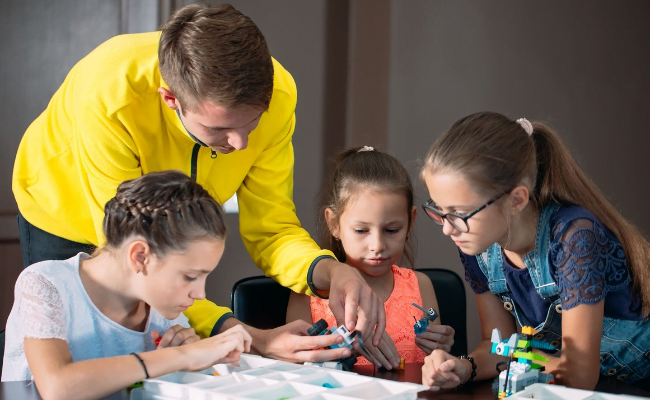Summer is a time for kids to enjoy the outdoors but it also brings safety concerns. Parents must be aware of the potential risks to keep their kids safe. This article provides important summer safety tips for kids, covering hydration, sun protection, swimming supervision, and more.
1. Keep Kids Hydrated
Hydration is crucial to prevent heat-related illnesses in kids.
- Regular Water Intake: Encourage kids to drink water regularly, even if they aren’t thirsty. Dehydration can happen quickly during summer activities.
- Avoid Sugary Drinks: Sugary drinks like soda and juice dehydrate more than they hydrate. Offer water or diluted fruit juices instead.
- Hydration Stations: Set up hydration stations with water bottles and cups in easily accessible areas.
- Signs of Dehydration: Be aware of signs of dehydration such as dry mouth, lack of sweat, and dark urine. Address these symptoms immediately.
- Electrolytes: In very hot weather, electrolyte drinks can help replenish lost salts, but consult with your child’s doctor first.
Hydration is essential for children’s health and helps in preventing more childhood injuries related to heat exhaustion and heat stroke.
2. Apply Sunscreen Regularly
Sun exposure is a major risk factor during summer, making sunscreen application vital.
- Choose Broad-Spectrum: Use a sunscreen that offers broad-spectrum protection with a sun protection factor (SPF) of at least 30.
- Apply Generously: Apply sunscreen to all exposed areas, and don’t forget often-missed spots like ears and the back of the neck.
- Reapply Frequently: Reapply every two hours, or more often if your child is swimming or sweating.
- Use Sun-Protective Clothing: In addition to sunscreen, dress your child in lightweight clothing, including long-sleeved shirts and wide-brimmed hats.
- Avoid Peak Sun Hours: Limit sun exposure between 10 AM and 4 PM, when UV rays are strongest.
These steps ensure effective sun protection for your child, reducing the risk of skin cancer and other sun-related issues.
3. Supervise Swimming Activities
Swimming is fun but comes with water safety risks. Supervision is key to keeping kids safe.
- Constant Supervision: Never leave a child unattended near any body of water, including pools, lakes, and wading pools.
- Learn CPR: Parents and caregivers should learn CPR. A quick response can save lives in case of a drowning incident.
- Life Jackets: Ensure kids wear properly fitted life jackets when they are in or around water bodies, especially if they are not strong swimmers.
- Designated Swimming Areas: Use designated swimming areas that are monitored by lifeguards for added safety.
- Swim Lessons: Enroll kids in swim lessons appropriate for their age and skill level to boost their confidence and safety in the water.
Implementing these water safety tips helps prevent drowning and ensures a safer swimming experience for kids.
4. Use Appropriate Protective Gear
Using the right protective gear significantly reduces the risks of injuries during outdoor play.
- Helmets for Biking: Ensure kids wear properly fitted helmets when biking, skateboarding, or rollerblading to prevent head injuries.
- Elbow and Knee Pads: Equip kids with elbow and knee pads to protect against scrapes and bruises.
- Proper Footwear: Encourage the use of closed-toe shoes during outdoor activities to prevent sprains and cuts.
- Sun Protective Clothing: Use sun-protective gear like wide-brimmed hats and UV-blocking sunglasses for additional sun protection.
- Gloves for Sports: Gloves can protect hands during sports like baseball or when climbing on playground equipment.
Using appropriate protective gear is an essential part of injury prevention for children during summer activities.
5. Educate About Stranger Danger
Teaching kids about stranger danger helps keep them safe when they are out and about.
- Communication Rules: Teach kids not to talk to strangers and to avoid accepting gifts or rides from anyone they don’t know.
- Safe Places: Identify safe places kids can go if they feel threatened, such as a trusted neighbor’s house or a public place.
- Buddy System: Encourage the buddy system. Kids should always go out in pairs or groups rather than alone.
- Know Contact Info: Ensure kids know their full name, address, and a parent’s phone number in case they need help.
- Role-Playing Scenarios: Use role-playing exercises to teach kids how to handle situations involving strangers, reinforcing what they’ve learned.
Educating kids about stranger danger is a proactive way to keep children safe during summer outings.
6. Ensure Safe Outdoor Play Areas
Safe play areas are crucial for preventing injuries during summer activities.
- Inspect Play Equipment: Regularly check playground equipment for any wear and tear or hazards that could lead to accidents.
- Soft Landing Surfaces: Ensure playgrounds have soft landing surfaces like sand or rubber to cushion falls.
- Shade and Shelter: Provide shaded areas to protect children from direct sunlight and prevent overheating.
- Fence Yards: Enclose play areas with fences to keep very young children from wandering into unsafe zones.
- Remove Hazards: Clear play areas of hazards such as broken glass, sharp objects, and animal waste.
Maintaining safe outdoor play areas helps prevent childhood injuries and keeps children safe during summer activities.
7. Monitor Insect Bites and Stings
Protecting kids from insect bites and stings is vital for their health during summer.
- Use Insect Repellent: Apply insect repellent containing DEET or other recommended ingredients to exposed areas of your child’s skin.
- Cover Up: Encourage kids to wear long-sleeved shirts and long pants when playing in areas prone to insects.
- Avoid Standing Water: Remove standing water from around your home to prevent mosquito breeding.
- Check for Allergies: Be aware of any allergies to insect bites or stings and ensure you have appropriate medication, like antihistamines.
- First Aid: Learn basic first aid for insect bites and stings. Know how to properly clean bites and recognize signs of allergic reactions or infections.
Monitoring and preventing insect bites and stings keeps children safe and healthy during their summer adventures.
8. Take Precautions Against Heatstroke
Heatstroke is a severe condition that can be life-threatening for children. Taking precautions is essential.
- Avoid Peak Heat: Keep kids indoors or in shaded areas during peak heat hours, typically between 10 AM and 4 PM.
- Lightweight Clothing: Dress children in lightweight, light-colored clothing to help them stay cool.
- Stay Hydrated: Ensure children drink plenty of water throughout the day to prevent dehydration.
- Rest Breaks: Schedule frequent rest breaks in a cool place when playing outside to avoid overexertion.
- Know the Signs: Be aware of heatstroke symptoms such as hot, red, and dry skin, rapid pulse, and confusion. Seek immediate medical attention if these symptoms occur.
Taking these steps helps prevent heatstroke and keeps children safe from overheating during hot summer days.
Schedule a back-to-school physical at Powers Pediatrics this July to ensure your child starts the school year healthy and ready!
Final Thoughts
Ensuring summer safety for kids involves taking proactive steps to protect them from various risks. From hydration and sun protection to water safety and insect bites, each measure contributes to a safer, more enjoyable summer. Implementing these summer safety tips and educating children about potential dangers will help them stay safe and healthy as they enjoy their summer activities. Always prioritize safety to reduce the risk of childhood injuries and ensure a fun-filled season for your kids.



